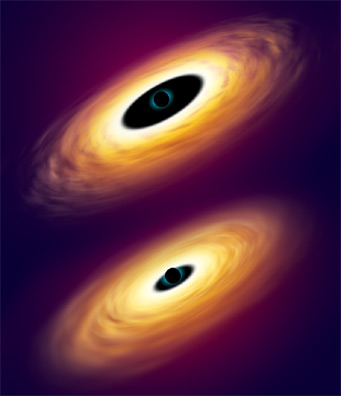
If a black hole rotates rapidly (bottom), the innermost stable orbit will be much closer to the hole”™s event horizon (surface) than if it turns slowly (top). This effect of general relativity can enable astronomers to deduce a black hole”™s spin rate.
S&T: Casey Reed; Source: NASA/CXC/Melissa Weiss
A black hole has been measured spinning more than 950 times per second, about as fast as it can theoretically go under the laws of physics.
How did astronomers figure this out? When X-ray-hot gas spirals in toward a black hole, it disappears before it actually gets there. When it gets closer than a distance known as the “innermost stable orbit,” the normal Newtonian laws of orbits break down, and the gas dives into the black hole in less than a millisecond. According to general relativity, the faster the hole’s spin, the closer matter can orbit before taking this final plunge.
In this case, a team led by Jeffrey McClintock and Ramesh Narayan (Harvard-Smithsonian Center for Astrophysics) determined that the inspiraling material vanishes about 30 kilometers (20 miles) from the black hole. Coupled with the hole’s known mass of 14 Suns, this yields an equatorial spin of at least 950 turns per second — nearly 100% of the theoretical upper limit for a hole of this size imposed by general relativity.
 0
0
Comments
You must be logged in to post a comment.